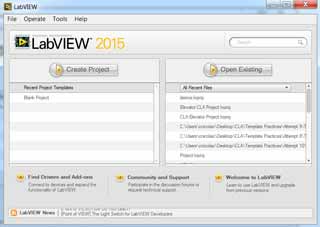What is LabVIEW?
LabVIEW is developed and produced by National Instruments as an environment used for graphical system design.
Logic Probe Tutorial Includes:
What is LabVIEW?
LabVIEW environment
LabVIEW VIs
Programming
Drivers
Example / tutorial
The name LabVIEW is a shortened form of its description: Laboratory Virtual Instrument Engineering Workbench.
LabVIEW is a visual programming language: it is a system-design platform and development environment that was aimed at enabling all forms of system to be developed.
LabVIEW was developed by National Instruments as a workbench for controlling test instrumentation. However its applications have spread well beyond just test instrumentation to the whole field of system design and operation.

LabVIEW is a graphical structured dataflow language sometimes referred to as “G” - not to be confused with G-Code.
History of LabVIEW
LabVIEW was first launched 1986 as a tool for scientists and engineers to facilitate automated measurements - the aim was that it would be a tool that would be as productive for scientists and engineers as spreadsheets were for financial analysts.
Says Jeff Kodowsky of National Instruments who came up with the initial idea and developed it: ”We weren’t seeking to create a language but that’s what we ended up doing because we needed that level of flexibility and control in order to deal with the kinds of IO and processing required.”
In addition to this, Kodowsky had been using an early Apple Mac which utilised graphics more than any other computing system. Kodowsky wanted to be able to utilise this capability to enable quicker programming of the control for instruments.
What is LabVIEW?
LabVIEW uses a graphic interface that enables different elements to be joined together to provide the required flow.
LabVIEW is essentially an environment that enables programming in G – this is a graphical programming language created by National Instruments that was initially developed to communicate via GPIB, but since then it has been considerably updated. Nowadays, G can be used for automated test applications, general data acquisition, programming FPGAs, etc . . . .
LabVIEW is essentially the user interface for G. However as the software has developed, the term LabVIEW is now synonymous with the G language. LabVIEW also provides a host of other facilities including debugging, automated multithreading, application user interface, hardware management and interface for system design.
In this way, LabVIEW acts as a portal for a variety of facilities, bring them together under a single element that is easy to manage.
LabVIEW runs on Windows, OS X (Apple) and Linux platforms, making it suitable for most computing systems.
LabVIEW key concepts
Within LabVIEW there are several elements and concepts that are key to the format and operation of the environment. These include:
- LabVIEW environment: The LabVIEW environment consists of LabVIEW VI manager (project explorer), the programming tools, debugging features, templates and ready built sample examples, and an easy interface to the hardware drivers. Read more about LabVIEW environment.
- LabVIEW VIs: The LabVIEW VI is a “Virtual Instrument” that enables a user interface to be built and it contains the programming code. Read more about LabVIEW Virtual Instruments, VIs.
- LabVIEW G programming: This is the graphical programming language where the functional algorithms are built using “drag and drop” techniques. Read more about LabVIEW programming.
- LabVIEW dataflow : This is the core concept that determines the running order for the programme.
LabVIEW applications
LabVIEW provides a powerful platform for undertaking a wide variety of different applications. It started as an environment for managing test programming, but since its inception, the applications for which it can be used have considerably expanded. It has expanded from being a graphical test management language to become a graphical system design environment.
This means that it can be used for an enormous variety of interesting and diverse applications. Not only can it be used for equipment control (including the control of the large Hadron Collider at CERN) and a variety of data acquisition applications (including car development simulation where Big Data monitoring is undertaken) to the system design arena where it has been used for development of projects from RF circuitry to biomedical equipment, green technology and much more.
LabVIEW advantages / disadvantages
Like any product or platform, LabVIEW has its advantages and disadvantages. These must be carefully considered before starting its use.
LabVIEW advantages
- Graphical interface is flexible and simple to use. Most engineers and scientists can learn to use it quickly.
- LabVIEW provides a universal platform for numerous applications in diverse fields.
- LabVIEW can be used with 3rd party hardware: it can be interfaced with C/C++, VB, Fortran etc etc.
- Easy to interface to many hardware items like data acquisition and test equipment products.
- It has excellent customer support and a large active community forum.
LabVIEW disadvantages
- LabVIEW is single sourced and some companies may not like to use a product that is single sourced and not standardised by the industry.
- Cost of ownership – although in line with many other industry products of a similar nature, its cost should be considered before it is introduced.
- For those more accustomed to text programming, graphical programming can take a little familiarisation time.
Like any product, LabVIEW has some disadvantages, but many who use it find it particularly effective. In view of this, LabVIEW should be carefully assessed before its use is introduced.
More Test Topics:
Data network analyzer
Digital Multimeter
Frequency counter
Oscilloscope
Signal generators
Spectrum analyzer
LCR meter
Dip meter, GDO
Logic analyzer
RF power meter
RF signal generator
Logic probe
PAT testing & testers
Time domain reflectometer
Vector network analyzer
PXI
GPIB
Boundary scan / JTAG
Data acquisition
Return to Test menu . . .



